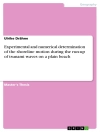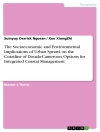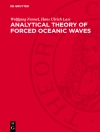This book presents a collection of papers under the theme of multi-hazard early warning and disaster risks. These were selected from the presentations made at the International Symposium on Tsunami and Multi-Hazard Risks, Early Warning and Community Awareness in supporting implementation of the Sendai Framework for Disaster Risk Reduction 2015-2030. This conference aimed to recognize achievements and to highlight work that still needs to be carried out. The conference promoted collaboration among academia, research institutions and disaster management offices, and further encouraged multidisciplinary and multi-sectoral interaction
This International Symposium on Multi-Hazard Early Warning and Disaster Risk Reduction provided an important opportunity to reflect upon our progress to date in tackling disaster risk, but also to consider some of the challenges and opportunities that lay ahead of us.
A particular focus of this event was Multi-Hazard Early Warning. During the negotiations for the Sendai Framework, countries and partners highlighted the need to:
1. Continue to invest in, develop, maintain and strengthen people-centred, end-to-end early warning systems;
2. Promote the application of simple and low cost early warning equipment and facilities;
3. Broaden the dissemination channels for early warning information to facilitate early action.
Countries also called for the further development of and investment in effective, nationally compatible, regional multi-hazard early warning mechanisms. To address these needs, global Target (g) of the Sendai Framework was adopted, namely to “substantially increase the availability of and access to multi-hazard early warning systems and disaster risk information and assessments to the people by 2030”.
As illustrated by recent events in Indonesia, it is also vital to address the challenge of cascading hazards that pose a tsunami risk, and the importance of linking tsunami early warning to a multi-hazard environment. However, moving towards a multi-hazard environment is complex and poses many challenges but can bring significant benefits in terms of efficiencies and also in recognising the links between hazards, such as cascading threats. We very much hope that this book will provide an important platform to address these and other challenges in addressing disaster risk, as well as supporting implementation of the Sendai Framework for Disaster Risk Reduction
Tabela de Conteúdo
Sendai Framework for Disaster Risk Reduction 2015-2030 / Sustainable Development Goals: Life two years after relocation: Status quo of natural hazard induced displacement and relocation in Kegalle, Sri Lanka.- Development of a legume-based disaster resilient emergency food product.- Applicability of drywall technology in disaster relocation projects: Time-based performance analysis.- Research and Innovation in the Context of Disaster Resilience in the Sri Lankan Higher Education Sector.- Role of the Built Environment in rebuilding Displaced and Host Communities.- Strategy for the establishment of Local Disaster Risk Reduction (DRR) Plans in Sri Lanka: a study on its effectiveness and challenges through a pilot programme.- Disasters, Climate Change and Development Nexus: Food Security Sector in Asia.- The Role and Challenges for Local Governments in Achieving the Resilience of Critical Infrastructure.- Role of Disaster Risk Resilient Cities in Facilitating the Achievement of Sustainable Development.- Disaster Risk Reduction: The Impact of PDO on South-west monsoon rainfall over Sri Lanka and monsoon- ENSO relation.- Local responsiveness to changes in climate: A case of underutilized marine and aquatic resources.
Sobre o autor
Professor Dilanthi Amaratunga
Professor Dilanthi Amaratunga holds the chair in Disaster Risk Management at the University of Huddersfield, UK. She is a leading international expert in disaster resilience with an extensive academic career that has a strong commitment to encouraging colleagues and students to fulfil their full potential. She provides expert advice on disaster resilience to national and local governments and international agencies including the United Nations Office for Disaster Risk Reduction. She is engaged in many significant disaster risk reduction and management research engagements around the world, in partnership with key academic and other organisational stakeholders. To date, she has produced over 400 publications, refereed papers and reports, and has made over 100 keynote speeches in around 30 countries. Among many leadership roles, she is the joint chief editor of the International Journal of Disaster Resilience in the Built Environment and the chair of the International Conference on Building Resilience (ICBR) series, which she co-created. She is a member of the European Commission and UNDRR’s European Science & Technology Advisory Group representing the UK, Steering Committee member of the Frontiers of Development programme, a Collaborative Programme of The Royal Academy of Engineering, The Academy of Medical Sciences, The British Academy and The Royal Society. She is a Fellow of the Royal Institution of Chartered Surveyors (RICS), a Fellow of The Royal Geographical Society, and a Fellow and a Chartered Manager of the Chartered Management Institute, UK. She can be contacted on: [email protected]
Professor Richard Haigh Richard Haigh is Professor of Disaster Resilience and Co-Director of the University of Huddersfield’s Global Disaster Resilience Centre in the UK. His research interests include multi-hazard early warning, disaster risk governance and resilience in the built environment. He is the Editor-In-Chief of the International Journal of Disaster Resilience in the Built Environment and Co-Chair of the International Conferences on Building Resilience, which started in 2008. He is an expert member of Working Group 1 of Intergovernmental Coordination Group on the Indian Ocean Tsunami Warning and Mitigation System (ICG/IOTWMS). Richard and his team won the Newton Prize for Indonesia, celebrating best research innovation partnership for the project Mainstreaming Integrated Disaster Risk Reduction and Climate Change Adaption Strategies into Coastal Urban Agglomeration Policy. He has led and successfully delivered research grants funded by the UK Natural Environment Research Council, the European Commission’s Horizon 2020, Erasmus+, Framework Seven Programme, Lifelong Learning, Asia Link and European Social Fund, the UK Newton Fund, the UK Foreign and Commonwealth Office, British Council and UK Parliamentary Under Secretary of State for Business, Energy and Industrial Strategy. Many of these projects were carried out in close collaboration with government, non-government organisations and industry partners. He has published widely, including an edited book by Wiley Blackwell, fifteen edited book chapters and forty-five peer reviewed journal articles, the majority of which are in ISI or SCOPUS indexed journals. He has delivered over 80 invited speeches and keynote presentations for audiences in twenty-five countries across North America, South America, Europe, Asia, Africa and Australasia.
Dr Nuwan Dias
Nuwan Dias is a Research Fellow in Disaster Resilience at the Global Disaster Resilience Centre, University of Huddersfield UK. His research interests include multi-hazard early warning, integration of climate change adaptation to disaster risk reduction and resilience in urban planning and Design. He has delivered over 10 invited speeches and keynote presentations for audiences in Europe, South Asia and South East Asia. Nuwan has chaired over 20 sessions in international conferences and presented his research work in more than 30 international audiences. Further, Nuwan has published in two edited book chapters and 12 peer reviewed journal articles. He is involved in developing research impact case studies for the UK Research Excellence Framework (REF2021) under the Unit of Assessment 13, Architecture, Built Environment and Planning. Nuwan has worked in many international research projects funded by the European Commission’s Horizon 2020, Erasmus+, Lifelong Learning and the Global Challenges Research Fund in different capacities. In his different roles, he has worked with multi-stakeholders including government, non-government organisations and industry partners. Nuwan earned his Ph D in Urban Design from the University of Huddersfield, UK, his Masters degree from the University of Salford, UK and the undergraduate degree from the University of Moratuwa, Sri Lanka. Further, Nuwan is a Fellow member of the Higher Education Academy of the UK. Nuwan can be contacted on: [email protected].












